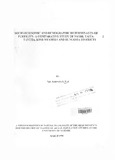| dc.description.abstract | This study examines and compares the socio-economic and demographic factors that affect fertility. Specifically, this study will estimate the effect of socio-demographic factors on overall fertility in Nyeri, Taita-Taveta, Kisii-Nyamira and Bungoma districts. In addition, the study attempts to draw some policy lessons from our findings.
The data in the study was drawn from the Kenya Demographic and Health Survey (KDHS) of 1993. Cross tabulations, simple bivariate regression and multiple regression were used to determine the relationship between total children ever born and socio-economic and demographic variables.
The findings of the study revealed that demographic determinant of fertility were; ages of respondents and age of respondents at first birth in all the four districts, current marital status and the number of living children in Taita-Taveta and Kisii-Nyamira districts. The socio¬economic factors which explained differences in fertility were secondary and above education and primary education in Nyeri and, respondents income in Taita-Taveta district. On the other hand, the desired family sizes that explained differences in fertility were a desired family size of between 4 and 5 children in Kisii-Nyamira and Bungoma districts. Finally, the proximate determinants of fertility in all the four districts was the use of traditional methods of family planning, while the use of modem methods of family planning in determined fertility in Nyeri and Taita-Taveta districts.
Therefore, in summary and as expected the factors found to be significant in explaining differences in fertility are namely; age of respondents and age of respondents at first birth, education level and ever use of any method of family planning in all the four districts. Marital status, number of living children, respondent's income and desired family size were the other
significant determinants of fertility. Contrary to the expectations, respondents work status was found not to be significant in explaining differences in fertility in all the four districts | en |

